Cheap Petrol & Diesel: How to Find the Best UK Fuel Prices
With fuel costs impacting everything from commuting to the weekly grocery shop, finding cheap petrol and diesel is a top priority for many UK drivers. As prices fluctuate daily and vary across regions, knowing how and where to buy cheaper fuel can save households hundreds of pounds annually.
This guide explains how UK fuel prices work, what drives them, and—most importantly—how to find the cheapest petrol and diesel near you.
What Affects Petrol and Diesel Prices in the UK?
Several key factors influence fuel prices at the pump:
-
Global oil prices: The cost of crude oil on the international market is the biggest single factor. When oil prices rise, petrol and diesel costs usually follow.
-
Exchange rates: Oil is traded in US dollars, so if the pound weakens against the dollar, UK fuel prices rise.
-
Fuel duty and VAT: UK fuel tax is among the highest in the world. Fuel duty is currently fixed at 52.95p per litre, plus 20% VAT.
-
Wholesale supply chain: Prices can fluctuate due to supply issues, refinery shutdowns, or seasonal demand spikes.
-
Retail competition: Supermarkets often undercut each other, especially in competitive areas. In rural locations, fewer options mean higher prices.
Supermarkets vs Branded Stations: Which Is Cheaper?
Supermarket forecourts—such as Tesco, Asda, Morrisons, and Sainsbury’s—typically offer cheaper prices than branded stations like Shell, BP, or Esso. That’s because they use fuel as a way to attract shoppers, often making very little profit from it.
While some drivers believe branded fuel is better for engine health due to added cleaning agents, independent testing suggests that supermarket fuel meets all required standards and is safe for modern engines.
How to Find the Cheapest Petrol and Diesel Prices Near You
1. Use Petrol Price Comparison Websites
One of the easiest and most reliable ways to locate cheap fuel is by using online comparison tools that track prices in real-time. Try these:
-
PetrolPrices.com – Offers postcode-based searches and regional price comparisons.
-
Confused.com Petrol Prices – Shows the cheapest nearby petrol stations.
-
RAC Fuel Watch – Offers daily updates on average fuel prices and trends.
These tools let you check pump prices across different locations and brands, saving you from driving miles just to save a few pence.
2. Join Supermarket Fuel Loyalty Schemes
Most major supermarkets offer loyalty schemes that provide money off fuel when you spend a minimum amount in-store. Examples include:
-
Tesco Clubcard: Earn points on fuel and redeem them for discounts.
-
Sainsbury’s Nectar: Collect points when filling up and use them for money off future purchases.
-
Morrisons More: Occasionally offers fuel vouchers with grocery spend.
These can shave a few pence per litre off your total cost, especially when combined with price-matching.
3. Fill Up Early in the Week
Fuel prices tend to rise towards the weekend, particularly ahead of bank holidays or school breaks. By filling up on Monday or Tuesday, you’re more likely to benefit from lower prices before they creep up.
Apps That Track Fuel Prices in Real-Time
Smartphone apps make it even easier to monitor fuel prices while on the go. The most popular ones include:
-
PetrolPrices (App Store / Google Play): Search prices within a set distance of your current location.
-
Waze: Best known as a navigation app, Waze also lets users report fuel prices at nearby stations.
-
AA app: If you’re an AA member, the app provides fuel pricing alongside other motoring tools.
These apps use data from users and petrol stations to keep prices accurate and updated.
Avoid Motorway Services for Refuelling
Filling up at motorway service stations can cost you 10p to 30p more per litre than forecourts off the motorway. This is because service stations operate in low-competition areas and cater to drivers with no other option.
If you must stop for fuel during a motorway trip, consider leaving at the next junction and heading to a nearby town. You can often find a supermarket forecourt within a few miles offering significantly lower prices.
Is Premium Fuel Worth the Extra Cost?
Premium fuels like Shell V-Power or BP Ultimate are marketed for their engine-cleaning and performance-enhancing properties. But unless you’re driving a high-performance or turbocharged engine, these fuels offer little noticeable benefit for the average vehicle.
Most cars run efficiently on standard unleaded petrol (E10) or diesel (B7). Unless your car manufacturer specifically recommends higher-octane or premium diesel, you’re better off saving the extra 10–15p per litre.
Tips to Reduce Fuel Consumption and Save Money
In addition to finding the cheapest fuel, you can reduce overall costs by driving more efficiently:
-
Drive smoothly: Avoid rapid acceleration and harsh braking.
-
Reduce speed: Driving at 60mph instead of 70mph can cut fuel use by up to 10%.
-
Lighten the load: Remove roof boxes or unnecessary cargo to reduce drag.
-
Check tyre pressure: Underinflated tyres increase fuel consumption.
-
Avoid idling: Turn off your engine if you expect to be stationary for more than 60 seconds.
Fuel Price Trends in the UK
According to the RAC’s June 2025 report, the UK’s average fuel prices are:
-
Petrol: £1.44 per litre (average)
-
Diesel: £1.52 per litre (average)
Prices vary widely by location. Urban areas with high competition (like London, Birmingham, and Manchester) tend to offer cheaper rates, while remote or rural regions often face higher costs.
To stay updated, check RAC Fuel Watch or AA Fuel Price Reports for weekly national trends.
Can You Stock Up on Cheap Fuel?
While it may seem smart to fill up every time prices drop, fuel has a limited shelf life—especially if stored outside of your vehicle. Petrol can degrade in as little as 3 months, and diesel starts to break down after 6 months.
Unless you own multiple vehicles or have a legitimate business need to store fuel, it’s best to only buy what you need. Hoarding petrol or diesel can also pose safety risks and violate local storage regulations.
Conclusion
Fuel prices will always fluctuate, but the right tools and habits can help you minimise your costs. By comparing prices, using loyalty schemes, and adjusting your driving habits, you can consistently pay less for petrol and diesel—without compromising on convenience or safety.
Make it a habit to check prices before you fill up. It takes only a few minutes, and over time, those pennies per litre add up to meaningful savings.
 Swan SD6060N 1.5 litre Stainless Steel Fryer with Viewing Window, Non-Stick Coating for Easy Cleaning and Adjustable Thermostat with Indicator Light, Detachable Basket Handle, 900W, Silver
Swan SD6060N 1.5 litre Stainless Steel Fryer with Viewing Window, Non-Stick Coating for Easy Cleaning and Adjustable Thermostat with Indicator Light, Detachable Basket Handle, 900W, Silver 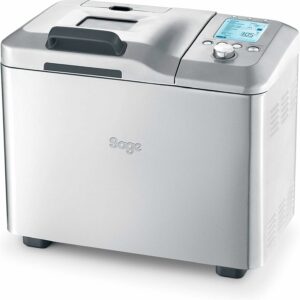 Sage - The Custom Loaf - Bread Maker, Brushed Stainless Steel
Sage - The Custom Loaf - Bread Maker, Brushed Stainless Steel 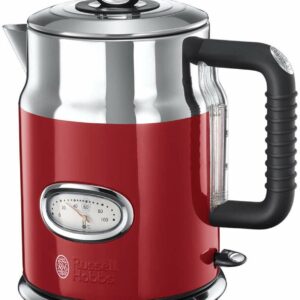 Russell Hobbs Kettle, retro red, 1.7 l, 2400 W, quick cooking function, water temperature display in retro design, filling level marking, optimised pouring spout, vintage 21670-70
Russell Hobbs Kettle, retro red, 1.7 l, 2400 W, quick cooking function, water temperature display in retro design, filling level marking, optimised pouring spout, vintage 21670-70  Sensio Home Personal Blender Smoothie Maker - BPA Free 1L Jar & 600ml Portable Sports Bottle, Electric Blender for Fruit, Vegetables, Protein Shakes, Crush Ice & Frozen Fruit, 2 Speed + Pulse 350W
Sensio Home Personal Blender Smoothie Maker - BPA Free 1L Jar & 600ml Portable Sports Bottle, Electric Blender for Fruit, Vegetables, Protein Shakes, Crush Ice & Frozen Fruit, 2 Speed + Pulse 350W 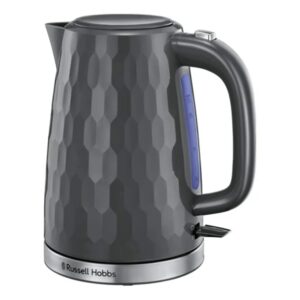 Russell Hobbs Honeycomb Electric 1.7L Cordless Kettle (Fast Boil 3KW, Grey premium plastic, matt & high gloss finish, Removable washable anti-scale filter, Push button lid, Perfect pour spout) 26053
Russell Hobbs Honeycomb Electric 1.7L Cordless Kettle (Fast Boil 3KW, Grey premium plastic, matt & high gloss finish, Removable washable anti-scale filter, Push button lid, Perfect pour spout) 26053  Rolling Kitchen Island Cart with Solid Wood Countertop Spice Rack and Wheels Portable Kitchen Cart (1 Piece)
Rolling Kitchen Island Cart with Solid Wood Countertop Spice Rack and Wheels Portable Kitchen Cart (1 Piece) 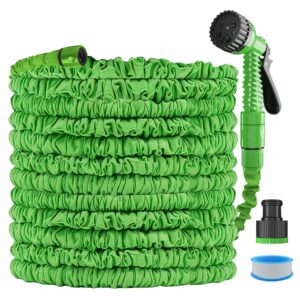 150FT Expandable Flexible Garden Hose with 7 Setting Professional Water Spray Nozzle
150FT Expandable Flexible Garden Hose with 7 Setting Professional Water Spray Nozzle 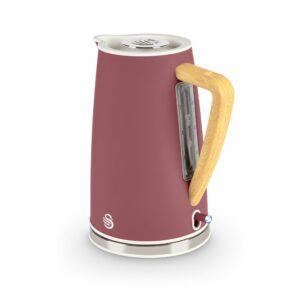 Swan SK14610FUS Nordic Cordless Jug Kettle with Fast Boil Technology, Overheat Protection, Soft Touch Handle, 1.7L, 3KW, Fuchsia Rose, Fusia
Swan SK14610FUS Nordic Cordless Jug Kettle with Fast Boil Technology, Overheat Protection, Soft Touch Handle, 1.7L, 3KW, Fuchsia Rose, Fusia 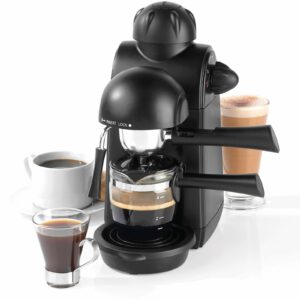 Salter EK3131 Espressimo Coffee Machine – 4-Shot Espresso Maker, Milk Frothing Wand, Includes 240 ml Glass Carafe, Barista Style Latte And Cappuccino, 5-Bar Pressure, Stainless Steel Filter, 870W
Salter EK3131 Espressimo Coffee Machine – 4-Shot Espresso Maker, Milk Frothing Wand, Includes 240 ml Glass Carafe, Barista Style Latte And Cappuccino, 5-Bar Pressure, Stainless Steel Filter, 870W 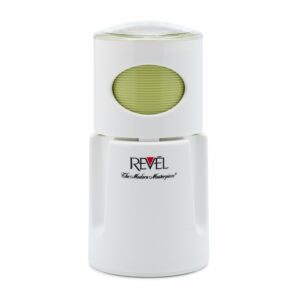 Revel CCM104 Wet and Dry Grinder, Plastic, White/Green
Revel CCM104 Wet and Dry Grinder, Plastic, White/Green 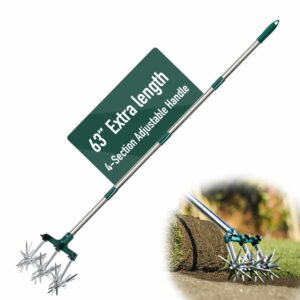 Rotary Cultivator Set, 25"-63" Adjustable Gardening Rotary Tiller and Hand-Held Garden Cultivator Tool with Steel Detachable Tines, Reseeding Grass or Soil Mixing
Rotary Cultivator Set, 25"-63" Adjustable Gardening Rotary Tiller and Hand-Held Garden Cultivator Tool with Steel Detachable Tines, Reseeding Grass or Soil Mixing 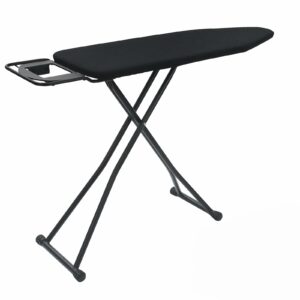 Rainberg 122 x 38cm Folding Ironing Board with Jumbo Iron Rest, Adjustable Height Up To 93cm, Foldable & Collapsible Ironing Table (Black)
Rainberg 122 x 38cm Folding Ironing Board with Jumbo Iron Rest, Adjustable Height Up To 93cm, Foldable & Collapsible Ironing Table (Black)  AOUXIN 3 Piece Rattan Garden Furniture Set, Outdoor Sectional Sofa with Coffee Table, Black Wicker, White Cushions
AOUXIN 3 Piece Rattan Garden Furniture Set, Outdoor Sectional Sofa with Coffee Table, Black Wicker, White Cushions